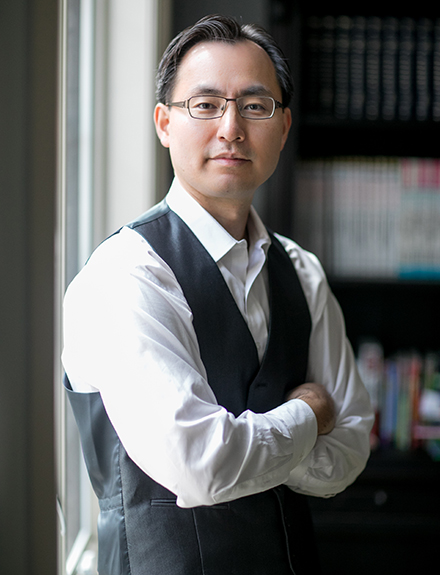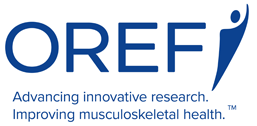

Samuel K. Cho, MD
OREF Young Investigator Grant
Research Topic
Identifying the growth factors and transcriptional regulators present as disk cells form and mature and what role they play in disk degeneration.
Patient Impact
Understanding of what growth factors and transcriptional regulators could be used to inhibit nerve and vascular ingrowth associated with disk degeneration.
In Search of a Biologic for Treating Back Pain
Two-time OREF grantee envisions injections to treat diskogenic pai
Sharon Johnson, OREF contributing writer
Could a simple injection effectively manage or eliminate back pain? With support from the Orthopaedic Research and Education Foundation (OREF), Samuel K. Cho, MD, is on the way to answering that question for patients living with intervertebral disk degeneration.
Substantial research has focused on the underlying cause of back pain: how to regenerate and repair degenerating disks. Dr. Cho and his colleagues are looking at symptom modification.
Dr. Cho, a spine surgeon and research scientist on the faculty at Icahn School of Medicine at Mount Sinai, New York, is leading an exploration of the molecular biology of notochordal cells. He is particularly interested in what chemical factors they may release or trigger that contribute to healthy disk cells. With the right combination of certain of those factors, he hopes to create a biologic cocktail capable of managing or even eliminating the pain that degenerating disks cause.
Oh, my aching back
Back pain is one of the leading reasons patients see a doctor. In addition to compromising patient health, back pain bloats health care costs and lost productivity. Health care and related expenses due to back pain are estimated at $100 billion annually.1-2 In the United States alone, more than 500,000 workers are affected and more than 100 million working days are lost every year.3-4
Much of that pain and expense appears to be associated with intervertebral disk degeneration. Spinal disks degenerate naturally with age. However, it is also believed that genetic, nutritional, and biomechanical factors contribute to disk degeneration, causing changes at the cellular level as early as age 1 or 2.
Current treatment options are limited and nonspecific. In a conservative care approach, patients generally work with a physical therapist to strengthen abdominal core muscles, and oral medication may be used to manage pain. Still, pain persists for many patients, reducing their quality of life and putting them at risk for other problems, such as depression.
The current alternative to noninvasive care is spinal fusion surgery, which Dr. Cho said is successful in about 60% of cases. In a fusion procedure, the surgeon eliminates the degenerated disk and immobilizes adjacent vertebrae. This results in loss of motion.
"Not only do you lose motion in the segment that is fused, but the biomechanical stress also goes to the segments above and below the fusion, potentially accelerating intervertebral disk degeneration there as well,” Dr. Cho explained.
Enlisting notochordal cells
In healthy young humans, notochordal cells are present in spinal disks. Their role is to assign other cells to specialize in order to form functional spinal components. For example, some cells respond by becoming bone, others by becoming disk or nerve tissue. Chemicals released by the notochordal cells orchestrate this work at the structural level.
Both in utero and early in life, notochordal cells contribute to the highly gelatinous nature of intervertebral disks by producing large quantities of proteoglycan and regulating the development of the disks’ complex cellular structure. However, all of that comes to a halt in early childhood, when human notochordal cells disappear.
By contrast, some animal species, such as pigs, retain notochordal cells through adulthood and do not experience disk degeneration.
"We want to better understand notochordal cells and learn what factors they release to the surrounding area that keep the disk cells healthy,” Dr. Cho explained.
Inhibiting pathways
In degenerating disks, sensory nerves and microscopic blood vessels infiltrate the gel-filled nucleus pulposus at the center of the disk and trigger pain circuits. Dr. Cho hypothesized that back pain could be managed by inhibiting that ingrowth.Specifically, Dr. Cho aimed to identify the growth factors and transcriptional regulators that are present as disk cells form and mature. With that knowledge, he saw the possibility of targeting and modulating specific genes associated with cell survival, differentiation and matrix deposition.
Using human nerve and endothelial cells, the research team conducted a series of in vitro experiments: cell culture, inhibition, and rescue/blocking studies. They followed these with in vivo experiments that incorporated the results of the in vitro studies. Using a rat model, the team evaluated the effects of injectable biologic factors, both for impact on disk degeneration and for effectiveness in inhibiting nerve and vascular ingrowth.
Learning what factors have an impact on disk degeneration could ultimately lead to medications that relieve patients’ diskcogenic pain,” said Dr. Cho.
Early encouragement
Participation in OREF-sponsored resident research symposia helped Dr. Cho cultivate his interest in research early in his career. The experience led him to apply for and secure a 2007 OREF/DePuy Resident Grant. That first OREF grant, he said, was “the impetus to continue my research efforts and continue my work in the lab and also in the clinic.Six years later, Dr. Cho was awarded a 2013 OREF Young Investigator Grant to pursue this and other work toward new therapies to treat patients with disk degeneration. He described the grant as a launching pad for his work as a clinician-scientist, treating patients and seeking biologic solutions for degenerative disk disease.
Said Dr. Cho, "The funding from OREF is providing invaluable preliminary data for long-term and bigger grants. With the results we obtain from the OREF-funded study, we’ll potentially see ways in which we can treat patients with disk degeneration."
References
1. Andersson GB, An HS, Oegema TR, Jr., Setton LA. Intervertebral disc degeneration. Summary of an AAOS/NIH/ORS workshop, September 2005. J Bone Joint Surg Am 2006;88:895-9
2. Katz JN. Lumbar disc disorders and low-back pain: socioeconomic factors and consequences. J Bone Joint Surg Am 2006;88 Suppl 2:21-4.
3. Cats-Baril WL, Frymoyer JW. Identifying patients at risk of becoming disabled because of low-back pain. The Vermont Rehabilitation Engineering Center predictive model. Spine (Phila Pa 1976) 1991;16:605-7
4. Kranzler LI, Schaffer L, Siqueira EB. Recent advances in the treatment of ruptured lumbar intervertebral disks. Neurol Clin 1985;3:405-16.
